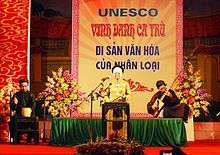Music of Vietnam
Traditional Vietnamese music encompasses a large umbrella of Vietnamese music from antiquity to present times, and can also encompass multiple groups, such as those from Vietnam's ethnic minority tribes.[1] Throughout its history, Vietnam has been most heavily influenced by traditional Chinese music, alongside with Korea, Mongolia and Japan.[2]

History

Traditional Vietnamese music has been mainly used for religious activities, in daily life, and in traditional festivals. Vietnam's ethnic diversity has also made its music scene diverse. Each of Vietnam's ethnic group owns many unique types of musical instruments. The influence of Chinese culture on Vietnamese music is also quite prevalent, such as maids, harps and erhu. However, traditional Vietnamese music, whilst often compared to traditional Chinese music, is not exactly the same.
Imperial court music
Nhã nhạc is the most popular form of imperial court music, specifically referring to the court music played from the Trần dynasty to the very last Nguyễn dynasty of Vietnam, being synthesized and developed by the Nguyễn emperors. Along with nhã nhạc, the imperial court of Vietnam in the 19th century also had many royal dances which still exist in present times. The theme of most dances is to wish the emperor or empress longevity and the country prosperity.
.jpg)
Classical music is also performed in honour of gods and scholars such as to Confucius in temples and shrines. These categories are defined as Nhã Nhạc ("elegant music" or "ritual and ceremonial" music), Đại nhạc ("great music"), and Tiểu nhạc ("small music") are classified as chamber music, often for entertainment for the ruler.[3][4][5][6][7] In Vietnamese traditional dance, court dances were encompassed van vu (civil servant dance) and vo vu (military dance).[8][9][10]
Dilettante music
Dilettante music is a genre of chamber music in the traditional music of southern Vietnam. Its instrumentation resembles that of the ca Huế style. Sometimes, modified versions of European instruments like the guitar, violin, and the steel guitar are also included. Vọng cổ ( meaning "Longing for the drum beat") is one of the more popular tài tử melodies, and was composed in 1919 by songwriter Mr Sáu Lầu, of Bạc Liêu, in southern Vietnam.[11]
Folk music
Vietnamese folk music is extremely diverse and includes dân ca, quan họ, hát chầu văn, ca trù, hò, and hát xẩm, among other forms.
Chèo
.jpg)
Chèo is a form of generally satirical musical theatre, often encompassing dance, traditionally performed by peasants in northern Vietnam. It is usually performed outdoors by semi-amateur touring groups, stereotypically in a village square or the courtyard of a public building, although today it is also increasingly performed indoors and by professional performers.
Xẩm

Xẩm or Hát xẩm (Xẩm singing) is a type of Vietnamese folk music which was popular in the Northern region of Vietnam but is considered nowadays an endangered form of traditional music in Vietnam. In the dynastic time, xẩm was performed by blind artists who wandered from town to town and earned their living by singing in common places.
Quan họ
Quan họ (alternate singing) is popular in Hà Bắc (divided into nowadays Bắc Ninh and Bắc Giang provinces) and across Vietnam; numerous variations exist, especially in the Northern provinces. Sung a cappella, quan họ is improvised and is used in courtship rituals.
Hát chầu văn
Hát chầu văn or hát văn is a spiritual form of music used to invoke spirits during ceremonies. It is highly rhythmic and trance-oriented. Before 1986, the Vietnamese government repressed hát chầu văn and other forms of religious expression. It has since been revived by musicians like Phạm Văn Tỵ.
Nhạc dân tộc cải biên
Nhạc dân tộc cải biên is a modern form of Vietnamese folk music which arose in the 1950s after the founding of the Hanoi Conservatory of Music in 1956. This development involved writing traditional music using Western musical notation, while Western elements of harmony and instrumentation were added. Nhạc dân tộc cải biên is often criticized by purists for its watered-down approach to traditional sounds.
Ca trù
Ca trù (also hát ả đào) is a popular folk music which is said to have begun with Ả Đào, a female singer who charmed the enemy with her voice. Most singers remain female, and the genre has been revived since the Communist government loosened its repression in the 1980s, when it was associated with prostitution.
Ca trù, which has many forms, is thought to have originated in the imperial palace, eventually moving predominantly into performances at communal houses for scholars and other members of the elite (this is the type of ca trù most widely known). It can be referred to as a geisha-type of entertainment where women, trained in music and poetry, entertained rich and powerful men.
Hò
"Hò" can be thought of as the southern style of Quan họ. It is improvisational and is typically sung as dialogue between a man and woman. Common themes include love, courtship, the countryside, etc. "Hò" is popular in Cần Thơ - Vietnam.
Ritual music
- Nhạc lễ - court music
Traditional musical instruments
- Đàn bầu (monochord zither)
- Đàn gáo (two-stringed fiddle with coconut body)
- Đàn nguyệt (two-stringed fretted moon lute)
- Đàn nhị (two-stringed fiddle with hardwood body)
- Đàn sến (two-string fretted lute)
- Đàn tam (fretless lute with snakeskin-covered body and three strings)
- Đàn tam thập lục (hammered dulcimer)
- Đàn tranh (long zither)
- Đàn tỳ bà (pear-shaped four-stringed fretted lute)
- Kèn bầu (oboe)
- T'rưng (bamboo xylophone)
- K'ni (also spelled k'ny or k'ný) - one-string vertical fiddle with a resonating disc that is held in the player’s mouth; played by the Jarai people of the Central Highlands
Classical music
Vietnamese composers also followed western forms of music, such as Cô Sao by Đỗ Nhuận, considered as the first Vietnamese opera. Hoàng Vân signed Thành Đồng Tổ Quốc, in 1960, considered as the first Vietnamese symphonie, and Chị Sứ as the first Vietnamese ballet in 1968, as well as the dozen of Choir with symphonic orchestra among his hundred famous patriotic tunes. Nguyễn Văn Quỳ also wrote 9 sonatas for violin and piano, following his French music studies and Vietnamese traditions.[12]
1940s–1980s, singer-songwriters

The Vietnam War, the consequent Fall of Saigon, and the plight of Vietnamese refugees gave rise to a collection of musical pieces that have become "classical" anthems for Vietnamese people both in Vietnam and abroad. Notable writers include Phạm Duy and Trịnh Công Sơn. Singers include Thái Thanh, Khánh Ly and Lệ Thu.[13][14][15][16]
Many of these composers, in the North, also contributed Vietnamese revolutionary songs, known as nhạc đỏ "Red Music": Lưu Hữu Phước, Văn Cao, Hoàng Vân, Nguyễn Xuân Khoát...
Modern music
V-pop

The embrace of modern pop music culture has increased, as each new generation of people in Vietnam has become more exposed to and influenced by westernized music along with the fashion styles of Hong Kong, Taiwan, Japan, and South Korea. Musical production has improved and expanded over the years as visiting performers and organizers from other countries have helped to stimulate the Vietnamese entertainment industry. Such performances include international stages like the Asia Music Festival in South Korea where popular Vietnamese singers such as Hồ Quỳnh Hương, Mỹ Tâm, Hồ Ngọc Hà, Lam Trường, Sơn Tùng M-TP and others have performed along with other singers from different Asian countries. During the recent years such as 2006 and beyond, Vietnamese pop music has tremendously improved from years past. Vietnamese music has been able to widen its reach to audiences nationally and also overseas. There are many famous underground artists such as Andree Right Hand, Big Daddy, Shadow P (all featured in a popular song called Để anh được yêu) or Lil' Knight and countless others who have risen to fame through the Internet. In addition, there are also other singers that have gone mainstream such as M4U, Hồ Ngọc Hà, Bảo Thy, Wanbi Tuấn Anh, Khổng Tú Quỳnh, Radio Band, etc. There are also amateur singers whose songs have been hits in Vietnam such as Thùy Chi. These singers tend to view singing as a hobby, therefore not being labeled as mainstream artists. Overall, the quality of recording and the style of music videos in Vietnam has improved a lot compared to the past years due to many private productions and also overseas Vietnamese coming back to produce a combination of Western and Vietnamese music.
Rock and heavy metal
Introduced by American soldiers, rock and roll was popular in Saigon during the Vietnam War. This genre has developed strongly in the South and has spread out over the North region after the rise of Bức Tường in the 90s. For the last 10 years, metal has become more mainstream in Vietnam. Ngũ Cung and Microwave are the current top Vietnamese metal bands in the 21st century.
Hip Hop
Derez is a Vietnamese and Black hip hop artist and URL battle rap emcee.
See also
References
- Ó Briain, Lonán (2018). Musical minorities : the sounds of Hmong ethnicity in Northern Vietnam. New York, NY. ISBN 9780190626976. OCLC 994287647.
- "Southeast Asian arts Vietnam". Encyclopædia Britannica Online. Encyclopædia Britannica. 23 July 2008. p. 36.
- Vietnam - Page 95 Audrey Seah, Charissa M. Nair - 2004 "There were three categories: dai nhac (dai nyahk) or great music, chamber music for the entertainment of the king, and ritual music- accompanying important ceremonies such as the one to ensure a good harvest. The Ly kings, in particular "
- International Workshop on Nhã Nhạc of Nguyễn Dynasty: Huế court music - Page 201 Huế Monuments Conservation Center, Ủy ban quốc gia Unesco của Việt Nam, Viện nghiên cứu âm nhạc (Vietnam) - 2004 "... by stricter rules. That was the rule in using "Great music" and "Small music". Great music ..."
- Tư liệu âm nhạc cung đình Việt Nam - Page 103 Ngọc Thành Tô,ön (Mounting the Esplanade-simple version), -Dàngdàn kép (Mounting the ..."
- Asian Pacific quarterly of cultural and social affairs - Volumes 3-4 - Page 67 Cultural and Social Centre for the Asian and Pacific Region - 1971 "Đại nhạc (literally : great music) or Cd xuy Đại nhạc iW&^k.1^), composed ... Tiểu nhạc (literally :small music) or // true Tiểu nhạc (UYrB%:) : small group of silk or stringed instruments and bamboo flute. Ty khanh: ... Traditional Vietnamese Music 67."
- Court Music "He with the profound knowledge about Vietnamese Court Music not only taught the performance skill of such repertoires as Liên hoàn, Bình bán, Tây mai, Kim tiền, Xuân phong, Long hổ, Tẩu mã extracted from Ten bản ngự (Small music); Mã vũ, Man (Great music) but introduced their origin and performance environment."
- International Workshop on Nhã Nhạc of Nguyễn Dynasty: Huế court music - Page 152 Huế Monuments Conservation Center, Ủy ban quốc gia Unesco của Việt Nam, Viện nghiên cứu âm nhạc (Vietnam) - 2004 "What is Dai nhac (great music) and what is Tieu nhac (small music)? On basis of terminology and canon-like document, there are some notions for our deep concern: - Nha nhac is a genre of music used by Chinese emperors in sacrifices to ..."
- Selected musical terms of non-Western cultures: a notebook-glossary - Page 132 Walter Kaufmann - 1990 "Dai nhac (Vietnam). "Great music." Ceremonial music of Temple and Royal Palace performed by a large instrumental ensemble. The instruments of a dai nhac ensemble were: 4 ken, ..."
- Visiting Arts regional profile: Asia Pacific arts directory - Page 578 Tim Doling - 1996 "Court orchestras were also organized into nha nhac ('elegant music') and dai nhac ('great music') ensembles and court dances were defined as either van vu (civil) or vo vu (military). Confucian music and dance was presented at court until ..."
- Garland Encyclopedia of World Music South East Asia p.262 Nhạc tài tử
- Nguyễn, Trâm (7 July 2011). Nguyen Van Quy - A Biography. Hanoi: Nguyễn Trâm. p. 38. Retrieved 23 October 2016.
- John Shepherd Continuum encyclopedia of popular music of the world: Volumes 3–7 - 2005
- Phạm Duy. 1975. Musics of Vietnam
- Olsen
- Popular Music of Vietnam 5 Sep 2010 – Popular Music of Vietnam: The Politics of Remembering, the Economics of Forgetting by Dale A.Olsen Routledge, New York, London, 2008
External links
| Wikimedia Commons has media related to Music of Vietnam. |
- BBC Radio 3 Audio (60 minutes): Tran Quang Hai in Hanoi. Accessed November 25, 2010.
- BBC Radio 3 Audio (60 minutes): Tran Quang Hai in Saigon. Accessed November 25, 2010.
- (in French) Audio clips: Traditional music of Vietnam. Musée d'ethnographie de Genève. Accessed November 25, 2010.
- Listen to traditional Vietnamese music
- The traditional music of Vietnam
- Traditional music of Vietnam from Vietnam-Culture.com
- International Institute For Vietnamese Performing Art (IIVPA)
- Encyclopedia of Vietnamese music
- Prosperity revives a tradition (Vietnam's live music for the dead) by Ho Binh Minh, Sunday April 18, 04:22 AM
- VietnamTourism.com: Traditional Theatre
- Vietnamese Institute of Musicology
- Việt Nam Cultural Profile - detailed overview of different music genres plus directory of key contacts
- Young Vietnamese pop culture music Da Nhat Yen
- Music of the Montagnards of Vietnam, part 1 - a panorama of tribal music in Vietnam by Tran Quang Hai
- Music of the Montagnards of Vietnam, part 2 - a panorama of tribal music of Vietnam by Tran Quang Hai
- Music of the Montagnards of Vietnam, part 3 - a panorama of tribal music of Vietnam by Tran Quang Hai

